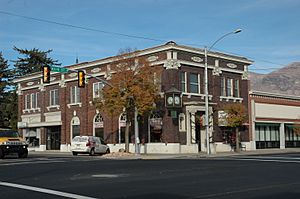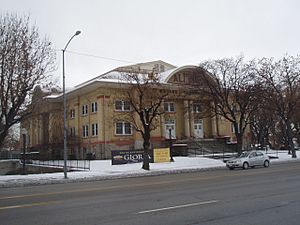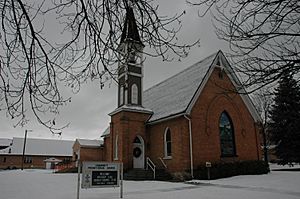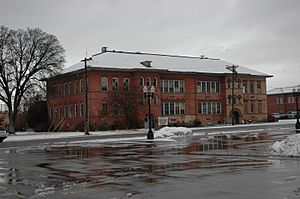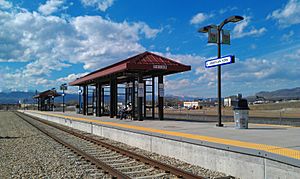American Fork, Utah facts for kids
Quick facts for kids
American Fork
|
||
|---|---|---|
|
City
|
||
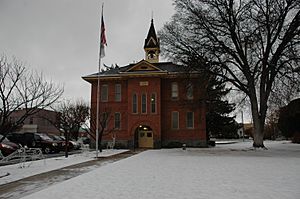
The old city hall is on the National Register of Historic Places.
|
||
|
||
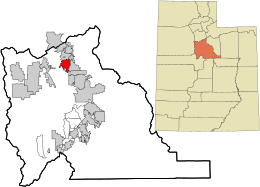
Location in Utah County and the state of Utah
|
||
| Country | ||
| State | ||
| County | Utah | |
| Settled | 1850 | |
| Incorporated | June 4, 1853 | |
| Named for | American Fork (river) | |
| Area | ||
| • Total | 11.16 sq mi (28.90 km2) | |
| • Land | 11.15 sq mi (28.87 km2) | |
| • Water | 0.01 sq mi (0.02 km2) | |
| Elevation | 4,613 ft (1,406 m) | |
| Population
(2020)
|
||
| • Total | 33,337 | |
| • Density | 2,987.19/sq mi (1,154.73/km2) | |
| Time zone | UTC−7 (MST) | |
| • Summer (DST) | UTC−6 (MDT) | |
| ZIP code |
84003
|
|
| Area codes | 385, 801 | |
| FIPS code | 49-01310 | |
| GNIS feature ID | 2409697 | |
American Fork is a city in Utah County, Utah, United States. It is located at the base of Mount Timpanogos and near Utah Lake. The city is about 32 miles southeast of Salt Lake City. American Fork is part of the larger Provo–Orem metropolitan area. In 2020, about 33,337 people lived here. The city has grown a lot since the 1970s.
Contents
History of American Fork
The area around Utah Lake was once used by the Ute Indians for hunting and fishing. American Fork was first settled in 1850 by Mormon pioneers. It was officially made a city in 1852 and was called Lake City.
Early settlers lived spread out along the American Fork River. In 1853, settlers were told to move into forts for safety. This was because of increasing tension with Native Americans. A fort was built, covering about 37 acres.
The city's name changed from Lake City to American Fork in 1860. This was to avoid confusion with Salt Lake City. The new name came from the American Fork river. In its early days, most people in American Fork were farmers and merchants.
Public Education in American Fork
American Fork was a leader in education. By the 1860s, it had the first public school in Utah. This meant it was the first community to offer free education to its citizens. Later, in 1892, Joseph Forbes helped organize the schools. A school is named after him today.
Mining and Industry in American Fork
In the 1870s, American Fork became important for mining. It served as a rail point for mines in American Fork Canyon. Later, in the 1900s, raising chickens and selling eggs became a big industry.
During World War II, the city's population grew. This happened when the Columbia Steel plant was built nearby. The city still celebrates its industrial past with an annual summer event called "Steel Days." The steel mill closed in 2001.
American Fork Hospital Development
American Fork built its first city hospital in 1937. A new hospital was built in 1950. In 1977, it was sold to Intermountain Healthcare. They built an even newer hospital in 1980.
American Fork in Movies
American Fork has been a filming location for famous movies. The carnival scene in the 1992 film The Sandlot was filmed here. It was shot on State Street by Robinson Park.
Parts of the 1984 movie Footloose were also filmed in American Fork. This includes a church scene and a gas station scene.
Geography of American Fork
The city of American Fork is located at different heights above sea level. Elevations range from about 4,566 feet to 4,619 feet.
The United States Census Bureau says the city covers about 9.2 square miles (23.9 square kilometers). All of this area is land.
People in American Fork
As of 2023, about 38,549 people live in American Fork. The city has about 10,240 households. The population density is about 3,457 people per square mile.
Most people in the city are White. About 9.9% are Hispanic or Latino. Other groups include Asian, Native American, Pacific Islander, and African American people. About 7% of the population are from two or more races.
Many young people live in American Fork. About 30.3% of the population is under 18 years old. About 9.7% are 65 or older. Nearly half of the population (48.7%) is female.
Most adults in American Fork have finished high school (94.3%). Many also have a bachelor's degree or higher (40.9%). The average household income in the city is about $90,490. About 6.8% of the people live below the poverty line. Most people own their homes (71.3%). The average value of a home owned by its resident is about $406,900.
In 2007, there were 2,754 businesses in the city. They made over $724 million in sales.
Religious Communities in American Fork
The first branch of the Church of Jesus Christ of Latter-day Saints (LDS Church) in American Fork started in 1851. Today, there are seven LDS Church stakes (groups of congregations) here. The Mount Timpanogos Utah Temple was also built here in 1996.
While many people in American Fork are members of the LDS Church, other faiths are also present. The Community Presbyterian Church was formed in 1877. St. Peter's Catholic Parish started in 1973. Other groups include Jehovah's Witnesses, Calvary Chapel, and Faith Independent Baptist Church.
Education in American Fork
Public schools in American Fork are part of the Alpine School District. The city has one senior high school, American Fork High School. There is also one junior high school, American Fork Jr. High. Five elementary schools serve younger students: Barratt, Forbes, Greenwood, Legacy, and Shelley Elementary.
There are also private schools, such as American Heritage School.
Transportation in American Fork
In 2012, the FrontRunner commuter rail line began operating in Utah County. This line connects cities along the Wasatch Front. American Fork has its own American Fork station on this line.
Notable People from American Fork
- Paul Dayton Bailey – author and publisher
- Merrill J. Bateman – former president of Brigham Young University
- Wayne Booth – literary scholar
- Reva Beck Bosone – first female U.S. Representative from Utah
- Witney Carson – ballroom dancer
- Stephen L. Chipman – prominent community leader
- D. Todd Christofferson – LDS Church leader
- Jordan Devey – former American football player
- Gary Herbert – former Governor of Utah
- Joshua James – folk singer-songwriter
- Grant Liddle – endocrinologist
- Mia Love – U.S. Representative from Utah
- Brandon Sanderson – fantasy author
- MyKayla Skinner – Olympic silver medalist in gymnastics
- Daniel Wayne Sermon – lead guitarist for Imagine Dragons
- Madison Snow – racing driver
- James LeVoy Sorenson – medical inventor
- Andrew Tolman – musician, formerly of Imagine Dragons
Exchange Program
American Fork has an exchange program with Indio, California. This is similar to a "Sister City" program, but within the United States.
See also
 In Spanish: American Fork para niños
In Spanish: American Fork para niños






